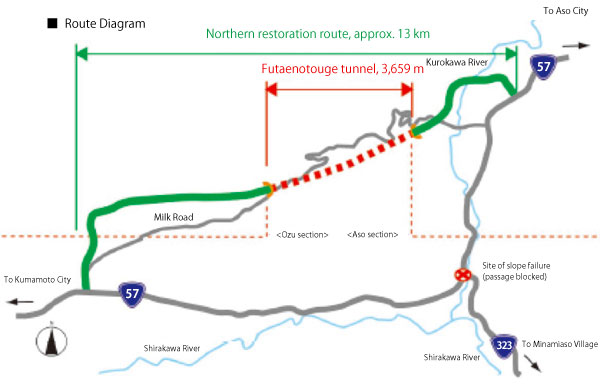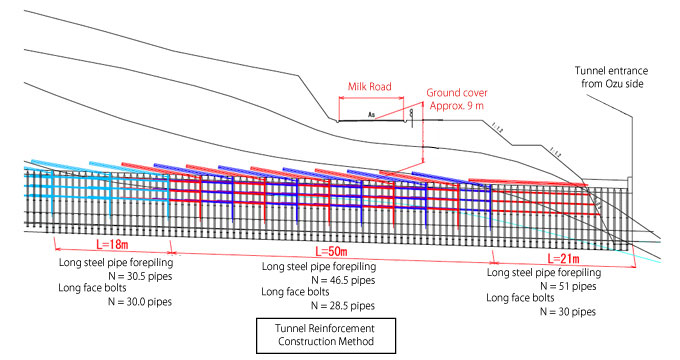October 24, 2017
A construction consortium for regional maintenance, consisting of Shimizu Corporation, Fukuda Corporation, and Matsushitagumi Inc. (hereafter, the "Shimizu joint venture"), completed excavation of a difficult 90-meter-long part of the Futaenotouge Tunnel (Ozu construction section) on October 14. The tunnel, which is designated as a Kumamoto earthquake recovery project, extends from the tunnel opening at Furujo in Ozu Town, and full-scale rapid construction will now begin. The Kitagairinzan-Ozu Prefectural road (nicknamed the "Milk Road"), an alternative route to National Highway No. 57, crosses the above-ground section of the most difficult part. The consortium succeeded in excavating the part safely and without any impact on road traffic by using the latest technology to stabilize the ground surrounding the tunnel and to prevent subsidence of the road surface. The Futaenotouge Tunnel, which runs through the somma encircling Mt. Aso, is the only tunnel part in the section of the northern recovery route (approx. 13 km) built on the north side of National Highway No. 57, which became impassable due to a large slope failure. It consists of a main tunnel that is 3,659 meters long and an evacuation tunnel that is roughly the same length at 3,653 meters long. The Shimizu joint venture will excavate 1,659 meters from the Ozu side, and a joint venture of the other companies will excavate the 2,000 meters from the Aso side.
The Shimizu joint venture received the order for the Ozu section on March 10 of this year. It began excavation of the evacuation tunnel (8.6 meters wide with a cross-section of 50 m2) in June, and on the main tunnel (15 meters wide with a cross-section of 106 m2) in August. The characteristic feature of the construction plan for this section is that the evacuation tunnel will be excavated first, then a cross-tunnel to the main tunnel side will be excavated once the evacuation tunnel reaches 1,000 meters in length. The main tunnel will then be excavated from that point toward the Aso side. This method will enable excavation of the main tunnel in two locations at once, shortening the construction period by a substantial amount. The entire construction period extends from March 11, 2017 to May 31, 2020.
At the point where the main tunnel crosses beneath the Milk Road, at about 40 meters from the tunnel mouth, the ground is very shallow and there is only about 9 meters of ground cover at the tunnel's peak. The ground was also weak in that location. The Shimizu joint venture therefore used the latest soil-reinforcing technology and improved the ground strength. About one meter of soil encircling the tunnel cross-section was reinforced in the direction of excavation to provide a roof-like covering in advance as it excavated. Concrete was also set on the floor of the tunnel immediately after excavation, and this rapid construction of a stable tunnel structure controlled ground deformation. Taking these steps enabled the Shimizu joint venture to keep ground surface subsidence to 20 millimeters or less.
Progress on the Ozu section of the tunnel up to today, October 24, has reached 128 meters on the main tunnel and 617 meters on the evacuation tunnel, and it is now 16% complete. The Shimizu joint venture will work to streamline the construction process so that it can complete the tunnel even one day faster than scheduled.
In selecting the contractors for this project, the Ministry of Land, Infrastructure, Transport and Tourism (MLIT) which commissioned the project, adopted the ECI (Early Contractor Involvement) method, which incorporates the opinions of the contractors from the design stage in order to achieve a quick start. Simultaneously working on the design and construction plans enabled the start of construction to be moved up by more than six months. During the ECI discussions, the Shimizu joint venture also proposed construction plans that incorporated simultaneous excavation of the main tunnel in two locations and various rapid construction techniques as ways to shorten the construction period. We consequently expect to finish excavation of the tunnel more than one year faster than normally expected.
<< For Reference >>
Construction Overview
| Project Name: | Futaenotouge Tunnel (Ozu section) of the Kumamoto No. 57 Disaster Recovery Project |
|---|---|
| Commissioned by: | Kyushu Regional Development Bureau, MLIT |
| Construction Period: | March 11, 2017 to May 31, 2020 |
| Construction Site: | Furujo in Ozu Town, Kikuchi-gun, Kumamoto Prefecture |
| Construction Details: | Construction section: 1,659m long Tunnels: Main tunnel: 1,659m long, 15m wide, cross-sectional area of 106m2 Evacuation tunnel:1,653m long, 8.6m wide, cross-sectional area of 50m2 Excavation method: NATM (New Austrian Tunneling Method), tunnel blasting method |
| Contract price: | 10.3 billion yen (tax excluded) |

Advanced Ground Reinforcement Technology
| Applicable Section | Directly beneath Milk Road (tunnel excavation length of 50 meters) |
|---|---|
| Ceiling Reinforcement | For every 5 meters of excavation, 46.5 steel pipes (alternating 46 and 47 steel pipes) that are 114.3 mm in diameter and 12.5 meters long are installed in the top half of the tunnel facing in the direction of excavation. The soil is improved by injecting a liquid mixture into the ground through the pores in the steel pipes. |
| Face Reinforcement | Face reinforcement is also performed for every 5 meters of tunnel excavation by installing 28.5 steel pipes having a diameter of 76.3 mm and 12.5 meters in length, and injecting the soil-improvement mixture. |

Fukuda Corporation
Tokyo headquarters: 3-2-4 Kudankita, Chiyoda-ku, Tokyo
Matsushitagumi Inc.
| Address: | 245-1 Yunoura, Ashikita-machi, Ashikita-gun, Kumamoto Prefecture-1 |
|---|---|
| President: | Yoshikazu Matsushita |
| Established: | January 1969 |
| Capital: | 80.5 million yen |
| Business Description: | Civil engineering architecture and construction contracting and residential housing, etc. |
The information contained in this news release is the current information on the date of publication. Please be aware that this information may have changed by the time you view it. Please contact the company to inquire for further details.
